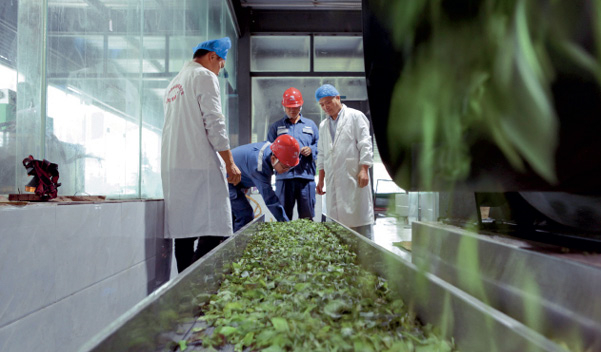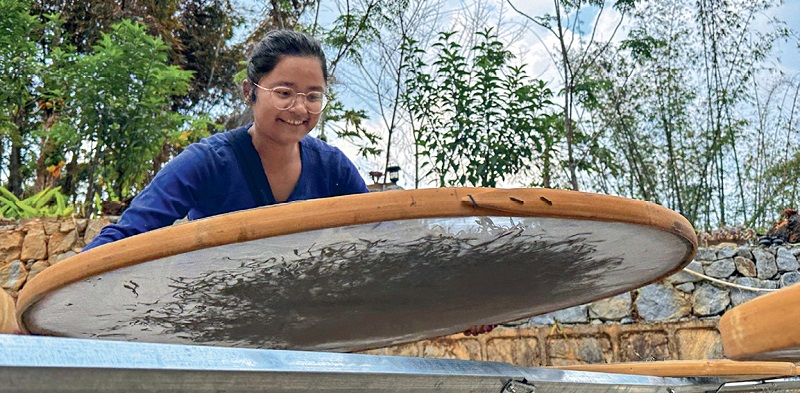China’s Jingmai Mountain Ancient Tea Forest has gained fame and revitalized villagers’ fortunes.
“Big tea trees in Aileng Moutain are in bud.
We cut the branches down, grow them in our village.
They withstand winds, rains, and time.
Precious as gold, they bring us fortune and happiness.”
Yu Luo, an elderly woman dressed in a traditional costume of the Blang ethnic group, sat in an old village and sang this beautiful folk song, praising the ancient tea forest that has supported her village for generations.
“For over a millennia, people here have been living with the tea forest. The small tea leaves are treasures that nature has given us,” she said.
Yu’s hometown is situated in Lancang Lahu Autonomous County in the city of Pu’er, southwest China’s Yunnan Province. Between the 10th and 14th centuries, when the ancestors of the Dai and Blang ethnic groups migrated here, they found wild tea trees. Overjoyed, they settled down, domesticated the wild tea trees and lived off them. For over a millennia, the story of tea trees and humanity unfolded here.

On sunny days, local villagers of Jingmai Mountain air tea leaves they picked from the ancient tea trees in their yards.
Maintain Ecological Balance
The ancient tea forest in Jingmai Mountain is located in a primitive forest with an average altitude of 1,500 meters. Below are villages, surrounded by protective partition forests, with paddy fields spread out across the river valleys at lower altitude. This setting ensures that the tea forest is not disturbed by human activities.
Seen from a distance, it is just a lush primitive forest growing on the mountain. Today, walking into the forest, amidst the clouds and mist, the millennia-old, 1,180-hectare ancient tea trees grow under tall banyan and camphor trees, alongside abundant epiphytes growing at ground level. The ancient tea forest is made up of 1,500 species in 134 families of native seed plants, and is home to more than 200 wild animals. It is a fine example of wildlife and plants coexisting in harmony.
“The taller trees shelter the ancient tea trees from wind, rain, and frost. Insects eat insects, and birds eat insects. That’s how the ecological balance comes into being,” said 81-year-old Su Guowen, a local villager of the Blang ethnic group.
Nowadays, the ancient tea forest supports three administrative villages, 15 settlements, and more than 6,000 people on the Jingmai Mountain. To protect the ancient tea forest, the governments of Pu’er City and Lancang County have revised more than 20 regulations, incorporating the management of ancient tea trees into village charters and stipulating that tea trees should only be harvested in spring and autumn. They must be allowed to rest and thrive in summer and winter.
The government has also spared no effort in carrying out years of education, enabling villagers to have a profound understanding of the symbiotic relationship between forests, ancient tea trees, and humanity. Protecting the tea forest is the priority of villagers, who weed the area manually, apply no chemical fertilizers or pesticides, and never catch birds or dig up wild medicinal herbs in the area.
Today, the Cultural Landscape of Old Tea Forest on the Jingmai Mountain in Pu’er, which consists of five sections of the old tea forest, nine traditional villages, and three protective partition forests between them, stands out as an example of well-preserved tea culture. For this reason, it was inscribed on the UNESCO World Cultural Heritage list at the 45th session of the World Heritage Committee in Riyadh, Saudi Arabia on September 17, 2023, bringing global attention to the site.
However, 30 years ago, the scene in Jingmai Mountain was different. Paddy fields, the main source of livelihood, were inadequate, and local production methods were not well developed. The local infrastructure was old and decrepit. It was very hard to travel in and out of the region, and therefore tea buyers were scarce, with those who did make the arduous trek paying a few cents per kilo of tea. After working in the tea forest for a year, a farmer’s family could only earn around US $100.
In order to make a better living, tea farmers switched to crops such as sugarcane, corn, and rice, as well as animal husbandry. Many young people left their hometowns and migrated to other cities looking for work.

During peak hours of tea processing, workers from the Pu’er Lancang Power Supply Bureau of the Yunnan Power Grid visit local factories to check on the power supply.
Modern Facilities, Greener Tea Parks
“In the 1990s, every household used an indoor fire pit to cook and burned pine wood for lighting. There were only three voltage transformers in Huimin Town, where the Jingmai Mountain is located. Later, the locals raised funds to build a small hydropower station, but still failed to alleviate the power shortage,” said Shen Fayong, the first director of Jingmai Power Supply Station, which is run by Yunnan Power Grid Co., Ltd. of China Southern Power Grid.
In 2002, the present Jingmai Power Supply Station, then called Huimin Power Supply Station, was set up. According to statistics, from 2002 to 2010, Yunnan Power Grid Co., Ltd. invested more than RMB 67 million in the construction of a power grid, distribution network, and power projects in areas with no electricity on the Jingmai Mountain, gradually lighting up every village and household.
Liu Jinrong, an employee of Yunnan Power Grid Co., was involved in these efforts. “The rural power grid renovation project on the Jingmai Mountain began in 2005 and ended in 2007. At that time, the roads up the mountain were not as easy to walk on as they are now. They were all muddy trails which cars couldn’t drive on, and shoes would sink into the mud on rainy days. All poles, power supplies, and construction equipment relied on manual labor to be carried up the mountain. Local residents voluntarily joined in to help,” recalled Liu.
In 2010, every household in the region finally had access to electricity. At the moment when his village was electrified, Su Guowen was filled with excitement, “Our nights were as bright as the day,” he said.
In addition, since 2010, to qualify for the Jingmai Mountain World Heritage application, Yunnan Power Grid Co. invested in a large number of power construction and renovation projects, including the insulation of 10kV electric cables, rural power grid upgrading, and the burying of cables underground in core ancient villages.
In order to protect local natural resources, the power cables bypassed the ancient tea forest and the protective forests, and all electric cables were buried underground. At the same time, a green channel was set up to reduce power outage time for users, and projects such as charging network construction were launched to promote the green development of the Jingmai Mountain. In addition, the power supply station established a customer service WeChat group, covering all village officials and executives of nearly 100 small and micro enterprises. Each grid manager is responsible for 2,675 customers, and they quickly popularized the mobile payment method in the mountainous region by visiting villages and households.
After significant improvement of infrastructure, tea processing has also been improved. In 2015, it required RMB 1,000 worth of firewood to burn in order to process one tonne of tea, while the sum was lowered sevenfold when processing the same amount of tea by electricity.
To protect the ecology of the Jingmai Mountain, the local government began to promote fully automated electrical production lines. With a stable electricity supply, more than 1,500 tea processing workshops quickly switched to electrical production lines. Replacing coal and firewood with electricity not only reduces carbon dioxide emissions, but also saves about RMB 800,000 in annual costs.
Nan Kang, former head of Mangjing Village, said that the moment when the machines burst into life, he knew local tea processing had entered the era of clean energy. “Electricity-powered tea processing is clean and environmentally friendly, saving two-thirds of time and lots of costs compared to before. Moreover, it permits heat to penetrate evenly through every leaf, hence the tea tastes better.”
Meanwhile, in order to reduce air pollution, four charging stations and eight charging guns have been put into use at the Jingmai Power Supply Station and the Huimin Tourism Town Square in Lancang County, making it convenient for villagers and tourists to charge electric vehicles for green travel.

Zhou Yuanhui, whose parents are tea growers, is drying freshly picked tea leaves in her yard. Photos courtesy of Fang Wanxin
Young People Return
For years, the Jingmai Mountain has adhered to a sustainable development path. It protects the area while developing it, and utilizes local natural resources in a scientific way.
Nowadays, not only is the environment pleasant, but the economy is also developing rapidly. What surprises the locals the most is that many young people are willing to return to start a tea business after graduating from college.
Yan Kan, a young man in his early 20s, is an example. Growing up in Mangjing Village, he left the mountains in 2015, when he was admitted to the College of Science at Minzu University of China.
“I’ve been living in the mountains since I was born. When I was a little boy, there was no electricity nor convenient transportation, so I always dreamed of getting out to a better place. The first time I got out of the mountain was when I went to a high school in the nearby county, and the second time was when I was admitted to a college in Beijing. Knowledge has changed my destiny,” said Yan.
During his college years, Yan tried to promote the unique features and cultural elements of his hometown, with the hope that more people could know about the Jingmai Mountain and have a taste of the local tea. In 2018, when the Jingmai Mountain’s application for world heritage nomination reached a critical period, he had the idea of returning to start a business.
After graduation, Yan headed back home and opened a homestay and cafe with local ethnic features. He combined the traditional culture of the Blang ethnic group and the natural elements of Jingmai with modern cuisine and fashion trends, providing visitors with an unforgettable travel experience.
“Being a world heritage site means it needs to be inherited by generations of people. I believe that it is my duty as a young man to protect, inherit, and develop the culture, ecology, and history of the Jingmai Mountain,” said Yan. There are many young people like him who have returned home to start their own businesses.
Nowadays, people in the Jingmai Mountain are building green organic tea gardens, improving the quality and the economic value of local tea. With the assistance of young entrepreneurs, the area has also built homestays with ethnic characteristics, and integrated the cultivation, production, marketing, and tourism of Pu’er tea, boosting the development of the ecotourism industry.
The return of young people has helped to promote local industrial upgrading. They’ve utilized e-commerce platforms to expand sales, greatly improving the lives of tea farmers and their sense of happiness.